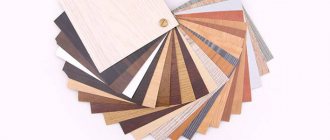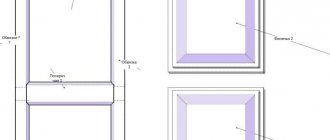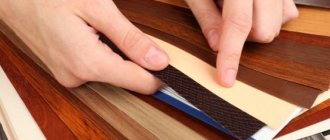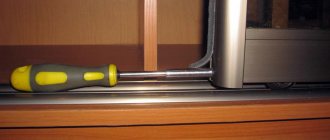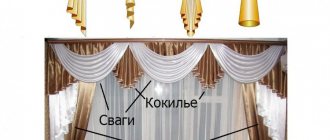On the eve of cold weather, insulating doors is more important than ever; according to statistics, up to 20% of the heat evaporates through a poorly protected entrance. You can solve this problem yourself. Next, we will try to figure out which insulation is better for metal and wooden doors, and home craftsmen will learn how to insulate entrance doors with their own hands quickly and efficiently.
Insulating the front door of a house or apartment is considered one of the components of comfort and provides significant savings during the heating season
How is heat lost?
Pay your attention first of all to the main line of defense - the entrance doors. If there are gaps between the door frame, then no amount of batteries will protect you from cooling outside.
A draft makes its way into the house between the jambs and sagging doors, which are formed for a number of reasons.
There are 3 main types of thermal insulation failure:
- Gaps between the boards of the door leaf. The space can be created by the expiration of material or padding, which creates cold bridges through which the cold enters directly into the house. To avoid this problem, remove these boards when adding filler and cover empty cells with it.
- The gap between the box and the canvas. It appears due to frequent use, poor quality material or installation.
It is highly not recommended to buy a wooden entrance door made of pine and spruce, because this material tends to dry out quickly. But doors made of dark exotic woods will serve you for decades.
Also, be careful during installation, because a few carelessnesses and you will have to re-cut and align the openings.
- Gaps between the opening and the wall. A common problem in older homes and damp areas. Over time, the material dries out and thermal insulation failure occurs. The problem is solved by using polyurethane foam, but only with precise and dense placement of the platbands. If you install them loosely, the foam collapses and loses its protective properties.
When you are completely sure that the source of the cold has been eliminated, then start insulating the wooden door!
Insulation process
Work order:
- The dimensions of the cells are measured, and then the pieces of insulation that are necessary are cut out from them. In the case of not provided “ribs” to impart rigidity to the structure, the cells are made with self-tapping screws and wooden blocks;
- The insulation is fixed in place. To do this, use either polyurethane foam or glue. Additionally, foaming of joints is carried out;
- When the door leaf is insulated, it is covered with a decorated panel made of any suitable material. For example, plastic, plywood, chipboard, etc. it is usually attached to a metal frame using self-tapping screws.
Choosing insulation
When choosing a material, pay attention to fibrous and porous structures. This filler is perfect for the front door of the house. Choose the number of layers individually depending on the resistance of the door frame and the wall as a whole.
The more you insulate the doors with your own hands, the better the thermal insulation will be. But keep in mind that the structure will become many times heavier!
It's time to start choosing insulation for the door:
- Styrofoam. One slab contains many small polyethylene pimples connected to each other. An effective thermal insulator, but life-threatening. It ignites in the first seconds and at warm temperatures evaporates toxic substances.
- Mineral wool. It consists of various rocks and processing. Unlike polystyrene foam, mineral wool is safe at high temperatures and does not contain toxic substances. This material is also protected from physical damage from rodents and cold temperatures, but has one significant drawback - it swells from moisture. To prevent yourself from replacing the filler, first protect it with lathing.
- Polyurethane foam. A practical product that can be applied to any surface using a spray can. Does not require any additional fastenings for fixation. A heat-resistant material that is difficult to ignite, but when burned decomposes into carbon dioxide and carbon monoxide.
- Foamed polyethylene. And finally, we recommend purchasing this moisture-resistant insulation when it comes to a sauna or bathhouse. Sold in rolls 10-15 mm thick, which is enough to eliminate drafts in the cracks and retain heat in the room. But polyethylene alone will not be enough, which is why it is used as an additional layer of insulation.
To make the insulation of a door at your dacha affordable, a small layer of structure is enough.
But still, if you are preparing for the winter in an active rhythm of life, with noisy neighbors, then be sure to install only large and warm doors, which in turn will protect you from unnecessary extraneous sounds from outside. And, of course, everything should look decent!
When do you need to insulate wooden doors?
Entrance door structures are a kind of shield that helps protect against a large number of external influences. Therefore, the products themselves must have maximum strength and reliability. Special characteristics are also important, guaranteeing protection from frost and heat, foreign odors and noise.
According to advice from experts, insulation is relevant under the following circumstances:
- The design was originally purchased without insulation, simply as free-standing doors.
- The old insulation of the selected type was installed poorly or was worn out during operation.
- The wooden door has lost its attractive appearance, even if it was installed correctly.
It is recommended to replace old insulation materials when more modern materials with improved characteristics appear. Doing the work yourself allows you to save maximum money.
Tools and materials
When you have finally decided which filler to use to insulate the doors, it’s time to prepare all the necessary tools:
- hammer;
- decorative nails;
- measuring instruments (tape measure, ruler, pencil);
- wood saw;
- sharpened knife for cutting;
- stapler and staples;
- pliers or nail puller;
- sealing tapes.
The list is impressive, but all items are necessary. And for this case there is an English proverb - “Necessity is the mother of invention.”
It is best to choose a leather substitute for upholstery. This material has many advantages: moisture-resistant, tension-resistant and easy to clean. Plus, it's available in many hardware stores and chain stores, so your search won't take long!
Self-installation of the seal
Insulating the door using various types of moldings is considered the simplest option. Actually, we do not touch the doors themselves, only the cracks around the perimeter are closed. The main material here is a self-adhesive cord; it can be made of porous materials or rubber.
- If the door is wooden, then the seal is glued to the groove of the frame. In the case when the door block is made of metal, the insulating molding is glued to the door. Now let's figure out how to properly glue molding to a wooden structure.
- First, the box is cleaned of the old seal, all nails are pulled out, and the surface of the groove is lightly sanded.
- Then you need to wipe the base from dust.
- The protective film is removed from the molding and the tape is glued from top to bottom along the very edge of the door frame.
- Horizontal seals are glued overlapping onto vertical strips.
- At the end, you need to cut the overlap of the two tapes at 45º and remove the excess.
Step-by-step instructions for installing a seal on a wooden door
Gluing the sealing tape to the edge of the metal door leaf is carried out in a similar way, but here, instead of light grinding, the surface of the metal must first be degreased with an alcohol-containing solution, for example, white spirit or cologne.
Before covering the perimeter of a metal door with sealing tape, it is advisable to degrease the base
Advice! There is now an inexpensive door sealing kit on sale that uses self-adhesive foam tape. Theoretically, there is nothing wrong with it, but the foam rubber takes 3 to 4 months, so this set is enough for a maximum of a season.
If polymer porous moldings can last up to 5 years, then self-adhesive foam tape wears out completely within a season
We insulate the door frame
And now the most important stage begins - insulating the front door. The first step is to eliminate all the cracks through which air gets in from the outside. They can be different - from noticeable to the smallest gaps between parts.
Your task is to place a seal around the entire perimeter of the box to block the cold bridges. It should be secured with the edges of the ribbon from the frame to the very edge of the door. Then the holes need to be filled with insulation. How to choose insulation for the front door was already discussed in the article.
Foam rubber or tow will work as a material, which needs to be pushed as deep as possible, creating a large layer. If the space is more than 5 mm wide, then polyurethane foam will be most effective.
Using a special nozzle, you can easily treat hard-to-reach places. But do not fill more than 50% of the free space with it, as the foam will grow over time and fill the void.
Insulation with dermantine
When the door itself allows air to pass through, it can be additionally equipped with one of the materials to improve the thermal insulation properties:
- Sintepon;
- Foam rubber;
- Penoizol;
- Isolon.
The last two materials deteriorate less, since they absorb moisture in much smaller quantities, especially if they are additionally covered with a metallized film.
For external insulation use:
- Leatherette (quite rare);
- Eco leather;
- Vinyl;
- Dermantin.
When choosing the last option, work is carried out in the following sequence:
- Installation of rollers, in which the material is shot with a stapler, while the backside remains on top and runs along the entire edge of the door;
- The device of the roller, made using a special material - foam rubber, must be installed in the prepared strip;
- If there is such a need, then the excess near the hinges is cut off, then nothing will interfere with the canvas opening and closing;
- All that remains is to re-attach the dermantine strips in the places adjacent to the door leaf;
- After making sure that the roller devices are ready, the insulating base is reattached to the door surface;
At the final stage, dermantin is fixed on top of the insulating layer, starting from the very center, so that there are no folds or distortions. Then the material must be precisely secured at the top and bottom to avoid sagging and nailed along the entire edge;
Make holes where both the lock and handles will be inserted. The door is decorated with fishing line or upholstery nails.
We insulate the door leaf
Now we are ready to begin the most interesting question: how to insulate a wooden door with your own hands? This means, get ready, you will have to knock down the entire door. To make it easier to remember the action plan, read the preparation instructions below:
- Remove all the fabric from the loops. You should eliminate all unevenness and deflections of the box to make sure there are no sources of cold. It is best to replace all old mechanical parts with new ones before installation.
- Cutting out components. If you already know the dimensions of the “wood guard,” then cut out the exact parameters for the insulation. Attach them to the panel using a stapler or glue, depending on the composition of the padding.
- Cover the wooden canvas with leatherette and start fixing it from the middle. If desired, leave the upholstery with an allowance of 1-2 cm for hems and decorations. And here, as fasteners, your decorative nails with a round hat will come in handy, which will add style to our “creation.” You can create a wide variety of patterns and designs with fishing line - just let your imagination run wild!
- Carefully iron the finished fabric to remove wrinkles and irregularities. If the weight of the door has increased noticeably since the start of work, then install an additional hinge between the two main ones. Security will never be unnecessary.
Video on how to insulate a wooden door
Door insulation
Entrance doors are most often made of two materials: metal or wood - depending on what type of door is installed in your home, the main features of the insulation process will depend. However, all doors have one common weak point - the gap between the door itself and the door frame, through which cold air from the street directly penetrates.
Insulation of the door perimeter
Self-adhesive tube insulation
- No matter how tightly the door fits, there will always be a certain gap between it and the frame . It is not a design defect, as it is necessary for the correct operation of the locking mechanism.
- It is almost impossible to remove the gap by adjusting the door for a tighter fit to the jamb - for this purpose it is more advisable to use a rubber or polymer-based tubular seal.
- First of all, the dimensions of the door are taken - the height and width are measured, which is then multiplied by two. Thus, you will get the length of the perimeter and accordingly find out how many linear meters of insulation you need to buy.
Note! When purchasing insulation, it is advisable to purchase 15–20% more linear meters. This will help you cover various unforeseen expenses - manufacturing defects, incorrect cutting or errors in calculations. The price of the tape is in most cases insignificant, so it will have virtually no effect on the total cost of the purchase.
Seal sticker
- Door insulation for the perimeter has the form of a strip, the width of which depends on the size of the door overlap . Its thickness is selected depending on the size of the gap.
As a sample, you can use a small piece of plasticine wrapped in polyethylene - place it between the frame and the door, and then close it. The thickness of the plasticine plate obtained in this way will be equal to the required thickness of the insulation in a compressed state.
Note! This parameter plays a very important role - an excessively thick tape will lead to the fact that the door will have to be closed with force, which is not very convenient and will lead to wear of the door mechanism, and a thin one will allow cold air to pass through.
The process of installing the tape is quite simple, since it has a self-adhesive base - you need to remove the glossy protective paper and stick it in the place where the door comes into contact with the door frame.
Insulation of an iron door
The metal version of the door most of all needs insulation, since steel has very good thermal conductivity - it freezes through within a few minutes. This is especially noticeable in severe frost - cold air begins to blow from the doorway.
If you have a door with a front steel base and a plastic or metal back, then the insulation can be placed in the middle of the door, since in most cases it is hollow.
The work order in this case will look like this:
Internal door insulation
- First of all, the back cover is removed - in most cases the door has a collapsible design, but if it is welded or riveted, then this will be discussed below;
- Then the insulation - polystyrene foam or expanded polystyrene - is cut to the size of the empty space. In this case, the second option is more appropriate, since it has a denser structure and is not so susceptible to deformation under the influence of heat;
- After the insulation sheets are inserted into the space allocated to them, they are fixed using polyurethane foam. All joints between the sheets of thermal insulation are foamed until a homogeneous structure is created, after which you can begin to reinstall the back cover;
Wooden frame for door
If the front door has the form of a steel sheet, welded with corners or steel strips, then the insulation follows the same scheme as described above, with the difference that you need to make a back cover. It can be made of either metal or a sheet of plywood, which is cut along the contour of the door and screwed with metal screws.
If the door has a solid structure and it is not possible to disassemble it, then a frame of wooden beams is assembled around the perimeter of the door, through which a hollow space and a base for the back cover will be created (which in this case will serve as the front part of the door). The timber is fastened using metal screws.
Note! The screw heads must be “sunk” in the frame so that they do not interfere with the installation of the cover in the future.
Insulation of a wooden door
By itself, wood has poor thermal conductivity, but after prolonged exposure to low temperatures, a wooden door can also freeze. In this case, the most common method of insulation in this case is external upholstery with foam rubber.
The order of work in this case looks like this:
Door removed from hinges
- The door is removed from its hinges and installed in a horizontal position on a hill (bricks, chairs). Then the surface of the door is cleaned of dirt, dust, swollen paint, etc. After which the surface is degreased with alcohol or a similar solution.
- A single sheet of foam rubber is cut to the size of the door. If the door has small side slots, cut out the corresponding side elements, which will be glued simultaneously with the main part. If the gaps are wide enough, then you need to select slats that match the width. Then the foam rubber is glued to the surface of the door with an adhesive composition.
- After the glue has completely dried, a sheet of water-repellent material is cut to the size of the door - dermantin, leather, etc. The dimensions of the sheet are calculated with a certain margin. Then the material is cut to form a frame that will frame the door and mask the ends of the main panel
- Using a stapler, the door is covered with the main blank along the edges, then, if there are large gaps, side slats are nailed, which must first be wrapped in foam rubber. After that, a frame is formed from pre-cut strips of material, which is fixed using furniture nails.
Frame formation
- The central part of the upholstery can also be fixed with furniture nails, with which you can create a decorative pattern using fishing line or cables.
Clearance seal and door interior trim
When your canvas is ready for installation, begin twisting strips of leatherette and insulation to join the door.
To get such a detail, you need to wrap the filler in a tube made of leatherette. The shape will resemble shawarma or sushi! With their help, the entrance will be tightly closed, leaving no space for through jambs.
Rolls can be secured using standard methods - nails or paper clips.
You should end up with a box with leatherette lining on all sides, which will insulate the heat escaping from the house and will tightly secure the ajar door when closed.
Preparing doors for trim
The work is carried out in stages, it is better to write a plan on paper and carry out all the actions according to it, this will help to avoid mistakes.
First you need to prepare the door. To make it easier to work with, the wooden door leaf is removed from its hinges using a nail puller. To do this, the canvas is pryed at the bottom, and it comes off its hinges on its own. If the awnings are rusty, they are lubricated with oil, and then they begin to remove the door, this is done so that the metal element does not break off. Then gradually turn the hinge, without sudden movements, and remove the door leaf.
When the doors are removed, all additional elements are removed from them, that is, eyes, handles, locks, and hinges. If the door is covered with another material, it must be removed so that access to the wooden material is open. The canvas needs to be placed in a convenient place so that it is comfortable to walk around it while fully performing the work.
Features of insulation of a metal split door
But how do you imagine insulating a metal door in a private house? Leaving it untouched would be a big mistake from a thermal insulation point of view.
For people who lived in the country, the theme of the vestibule is well known. This front part is designed to prevent air from the street from entering directly into the home. But most people don’t know about insulating a metal entrance door. And there is nothing complicated about it.
You will need to do the same technique with the seals for the box. Choose rubber gaskets and install them along the entire contour of the box.
This material is certainly the best, for its price, availability and durability - it justifies all its shortcomings. But do not forget to remove and degrease the previous seal, if there was one previously. Only then start preparing the front door in a private house for winter.
Video on how to insulate a metal door
Installation of a duplicate entrance door
This solution was actively used by consumers at the end of the last century, when the technology for manufacturing entrance doors had not yet been perfected. Today, this technique is used less frequently and exclusively for economy class steel doors. There are two basic options for installing a duplicate door leaf:
- Using one box. This option is rarely used, since the second door is usually made of wood, and the outer door is made of metal, which requires different frame materials.
If both panels are made from similar materials, then this solution significantly reduces the cost of the design, and installation is carried out in one stage.
The solution of installing two wooden doors is actively used in Finland to fill openings in energy-efficient private houses.
Wooden double door
- Using two differentiated frames - this technique is usually used if a second door is installed in an apartment or private house with the old door already installed. In such situations, the metal product is mounted in alignment with the outer edge of the wall structure so as not to interfere with the normal functioning of the previously installed door.
Duplicate doors in the apartment
When combining wooden and metal entrance doors for one opening, the maximum energy efficiency of a living space is achieved, since not only the materials of each of the panels, but also the air gap between them participate in the resistance to heat transfer.
Things to consider
From the point of view of effective thermal insulation, the quality and price of the purchased door are not the main success factor. If there are violations associated with cold bridges, no amount of fabric replacement will help. Just as in the case of a wooden door, you need to completely solve the problem of blowing cold in the area between the frame and the leaf.
Please note that much of the success depends on good heat treatment of the through gaps. Pay attention to which side of the canvas you are installing the mineral wool on. If you place the filler outside, then all the condensation will evaporate outside, and not into the room. This way you will protect yourself from excessive humidity and dampness.
Cutting and laying insulation
The next stage of insulating the door leaf will be laying material that will make it warmer . To do this, you need to arm yourself with a stationery knife. Thermal insulation is cut to the length and width of the sheet so that there is no empty space left. If the door is a frame with voids, then they need to be filled with insulation.
The insulation is tightly inserted between the bars
All pieces must be tightly inserted between the bars to prevent the formation of cold bridges. At the same time, the material should not bubble, which would indicate an excessively large supply. In this case, it is worth cutting off a little excess material. Once everything is adjusted, you need to secure the insulation with staples. A construction stapler allows you to do this quickly and efficiently.
Common Mistakes
Let's briefly talk about what not to do and how to avoid being a victim of failure:
- Foam insulation. When choosing a material for sealing the joint between the door and the frame, abandon the idea of foam rubber parts. The reason lies in the fact that this filler quickly breaks down and loses its properties. And if the “guard” is used frequently, the insulation will need to be replaced after a couple of months of winter.
- Foaming the box. Polyurethane foam, like nothing else, is suitable for insulating hard-to-reach places, including door frames. But do not overdo it when applying liquid to the surface!
If this is your first time touching a can, remember that the foam significantly increases in volume after sealing.
In this case, the insulation will end up in all possible places: from wallpaper to the insides of mechanical locks. Otherwise, you will have to deal not only with insulation, but also with parallel repairs.
That's all! Now, you can independently check in practice how to insulate a door with your own hands, and create comfort in your home and family budget.
How to avoid freezing your front door
If a consumer purchases a new entrance door, he should take care of its thermal insulation properties in advance. To do this, you need to take into account the following nuances when purchasing a product at a retail outlet, as well as during installation:
- The canvas must be straight, free from defects and bends that will affect the presence of cracks in the future.
- For installation, you should invite professionals with specialized tools who guarantee the results of their work.
Entrance door installation by professionals
- You should purchase products only from well-known manufacturers who have been supplying their products to the domestic market for a long time and have many positive reviews from satisfied customers.
- When choosing frames and handles for doors, you should buy products that have a thermal break with plastic inserts, which significantly reduces the risk of cold transfer.
Door profile with thermal break
Most well-known manufacturers conduct multi-stage testing of their products before launching into mass production.
Door handle with thermal break
Each test is carried out by external laboratories with a certificate of conformity, which indicates the characteristics of the canvas, box and other elements of the enclosing structure.
Door after insulation in the interior
Plastic
Installation of insulation is carried out similarly to wooden structures. A plastic door, which is covered with dermantine on top, will provide good protection from the cold. Only here it is necessary to replace the nails with construction glue. The process goes like this:
- remove the door;
- remove the fittings;
- install insulation;
- lubricate the structure and all elements, and then install the handles back;
- decorate the surface according to personal discretion.
Advice from professionals
The following recommendations from experienced craftsmen will help you avoid common mistakes when insulating a wooden front door:
- It is more effective to use heat-insulating material on both sides.
- You should choose consumable components from trusted manufacturers.
- The selected material must have high performance characteristics.
- The outer cladding must be resistant to precipitation.
- Each stage must be treated with full responsibility.
In the video on how to insulate a door with leatherette with your own hands, you can get acquainted with some of the features of the work:
Insulation of wooden window openings
Often, wooden windows are used to construct an attic. Not all owners nowadays want to replace wooden openings with plastic windows. Such windows have their negative sides, so a good solution would be to install wooden frames with plastic double-glazed windows, but their cost will be very high.
Insulating simple windows will be much cheaper and easier, you just have to find out how to do it. To effectively insulate window openings in wooden windows, you must first find out where the weak points are.
Then you can select the appropriate material and start working. The insulation procedure can be carried out using different methods. This is where aged newspapers can come in handy to create a form of heat insulator. You may also need foam rubber insulation, using it you can achieve a tight seal to the frame.
Metal constructions
Steel input blocks have a high heat transfer coefficient. This is a kind of “bridge” through which cold from the street enters the room (even when the door is sealed: the leaf is tightly adjacent to the opening).
To insulate a door yourself, it is better to use a standard kit (it includes the necessary tools and consumables): such a kit will help even someone who is just a novice master to cope with this work with ease. Most blocks designed for entry doorways have a hollow design. To reduce the heat transfer coefficient of such door systems, they are insulated.
The operation is performed as follows:
- Remove the steel sash from its hinges.
- Door handles, locking mechanisms and adjusting fittings are removed from the canvas.
- Beams (10x10 mm) are screwed along the perimeter of the inner part of the structure.
- Thermal insulation material is laid (it can be mineral wool, felt or polystyrene foam).
- Using special nails, the upholstery is attached to the beams.
- The fittings are installed on the sash.
- The canvas is hung on hinges.
Sealing with rollers
The upholstery of a country house door from the outside must be completed by installing special rollers. To make them, you will need to cut 4 strips 10 cm wide. The length of 2 strips is equal to the width of the wooden panel with an allowance of 10 cm. The other 2 parts are cut according to the height measurement, not forgetting to leave the same allowance (10 cm).
It is necessary to cut strips from foam rubber or other filler, the length of which corresponds to the length of the leatherette parts, and the width is 2-3 cm less. You can insulate wooden entrance doors with rollers both before and after installing the paneling.
Installation
Place the previously prepared leatherette parts along the edge of the door: long strips in height and short strips in width. Laying is done inside out so that the edge of the strip is at a distance of 1-2 cm from the edge of the wooden base. Fastening can be done with staples of a construction stapler or small nails with an enlarged head (upholstery nails). The fastening pitch is 10-15 cm along the entire perimeter of the canvas.
For better thermal insulation of doors, a strip of insulating material should be laid on a nailed strip of leatherette, 1 cm away from the edge. Bend the roller lengthwise in half so that the insulation is inside the upholstery. Tuck in all free edges and secure the edge of the roller to the wooden panel with decorative nails.
The fastener also performs a finishing function. Nails can be driven in at random intervals and even close to each other, but you need to ensure that they are evenly placed. The installation is completed by fastening the previously removed fittings: you need to cut holes for the handles, and fasten the locking plates over the upholstery.
Table of thermal insulation properties of materials
| Material | Density in kg/m3 | Minimum layer, cm | Thermal conductivity | Hygroscopicity | |
| Roll | Glass wool | 75-175 | 10-15 | G | B |
| Minvata | 35-125 | 10-15 | G | B | |
| Stitched mats | 75-150 | 10-15 | G | B | |
| Plastif | 50-60 | 2 | G | D | |
| Izover, URSA | 35-125 | 10-15 | G | B | |
| Penofol | 60-70 | 5 | G | IN | |
| Expanded polystyrene | 30-40 | 10 | D | IN | |
| Polyurethane foam | 30-60 | 10 | D | IN | |
| Plate-sheet | Styrofoam | 35-50 | 10 | D | IN |
| Mipora | 25-40 | 10 | D | IN | |
| From mineral wool and glass wool | 75-250 | 10-15 | G | B | |
| Woody-fibrous | 250 | 1.5-3 | B | A |
Legend:
- A - Very high.
- B - High.
- B - Average.
- G - Low.
- D - Very low.
Today, several methods of insulation are possible. You can:
- secure the seal to the box;
- upholster the canvas with insulation;
- seal the opening using rollers.
Let's take a closer look at each of the options.
Where and how to use insulation with foil?!
We have previously told you about how to properly use this insulation; you can find out more about this here
Do-it-yourself door upholstery with dermantine
Let's briefly look at the technology of how to sheathe a door with dermantine. After the insulation is laid, it is covered with dermantine, which must be wrapped and secured around the perimeter of the door leaf with nails. The dermantine upholstery starts from the top of the door. During the installation process, you need to ensure that the insulation does not move to the side, and that the dermantine is stretched without distortions.
Note. This installation method, despite its obvious simplicity, has a drawback - the place where the dermantine is attached can tear, so rollers are often installed at the place where the dermantine is installed.
Door upholstery with dermantine with rollers
The cladding method involves the use of rollers to cover the place where the dermantine is attached and the gap between the door and the frame, so as not to blow.
It's easy to make rollers - you need to cut strips from the finishing material - 4 pcs. Strip sizes: width 50-200 mm, length equal to door height (2 pcs.) and width (2 pcs.)
Note. If the hinges are installed outside, the bolsters are installed only on the handle side.
The cut pieces of dermantine are attached around the perimeter of the door, a round-shaped seal is placed in them (in this case, the width of the workpiece is 50-70 mm), or twisted insulation, or dermantine folded into a roller (then the workpiece reaches a size of 200 mm). Dermantin covers the insulation, is wrapped and fixed around the perimeter.
The use of rollers allows you to beautifully decorate the place where the dermantine is attached to the door leaf and additionally protects against the penetration of cold through the door gap.


